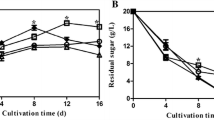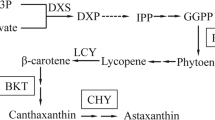Abstract
Liquid static cultivation of Ganoderma lucidum was previously found to be very efficient for improving the production of its valuable antitumor compound ganoderic acid (GA) (Fang and Zhong in Biotechnol Prog 18:51–54, 2002). In this work, effects of oxygen concentration within the range of 21–100% (v/v) in the gaseous phase on the mycelia growth, GA production, and gene transcription of key enzymes for GA biosynthesis in liquid static cultures of G. lucidum were investigated. A high cell density of 29.8 ± 1.7 g/l DW and total GA production of 1427.2 ± 74.2 mg/l were obtained under an optimal gaseous O2 level of 80%. The expression of 3-hydroxy-3-methyl-glutaryl-CoA reductase, squalene synthase and lanosterol synthase genes of GA biosynthetic pathway as detected by quantitative real-time PCR was also affected by the gaseous oxygen concentration in the liquid static culture. H2O2 was generated as reactive oxygen species in response to high oxygen concentrations in the gas phase, and it seemed to be involved in the regulation of GA biosynthesis. The information obtained in this study provided an insight into the role of gaseous O2 in the GA production and it will be helpful for further enhancing its productivity.




Similar content being viewed by others
References
Yang FC, Yang MJ, Cheng SH (2009) A novel method to enhance the mycelia production of Ganoderma lucidum in submerged cultures by polymer additives and agitation strategies. J Taiwan Inst Chem Eng 40:148–154
El-Mekkaway SR, Meselhy M, Nakamura N, Tezuka Y, Hattori M, Kakiuchi N (1998) Anti-HIV-1 and anti-HIV-protease substances from Ganoderma lucidum. Phytochemistry 49:1651–1657
Luo J, Lin ZB (2002) Advances of pharmacological effects of triterpenes from Ganoderma lucidum. Acta Pharmacol Sin 37:574–578
Zhong JJ, Tang YJ (2004) Submerged cultivation of medicinal mushrooms for production of valuable bioactive metabolites. Adv Biochem Eng Biotechnol 87:25–59
Song M, Kim N, Lee S, Hwang S (2007) Use of whey permeate for cultivating Ganoderma lucidum mycelia. J Dairy Sci 90:2141–2146
Fang QH, Zhong JJ (2002) Two-stage culture process for improved production of ganoderic acid by liquid fermentation of higher fungus Ganoderma lucidum. Biotechnol Prog 18:51–54
Tang YJ, Zhong JJ (2003) Scale-up of a liquid static culture process for hyperproduction of ganoderic acid by the medicinal mushroom Ganoderma lucidum. Biotechnol Prog 19:1842–1846
Han O, Mudgett RE (1992) Effects of oxygen and carbon dioxide partial pressures on Monascus growth and pigment production in solid-state fermentation. Biotechnol Prog 8:5–10
Tang YJ, Zhong JJ (2003) Role of oxygen supply in submerged fermentation of Ganoderma lucidum for production of Ganoderma polysaccharide and ganoderic acid. Enzyme Microb Technol 32:478–484
Yeh SF, Chou CS, Lin LJ, Shiao MS (1989) Biosynthesis of oxygenated triterpenoids in Ganoderma lucidum. Proc Natl Sci Council ROC(B) 13:119–127
Lichtenthaler HK, Rohmer M, Schwender J (1997) Two independent biochemical pathways for isopentenyl diphosphate and isoprenoid biosynthesis in higher plants. Physiol Plant 101:643–652
Kroon PA, Threlfall DR (1997) Squalene synthase from cell suspension cultures of Tabernaemontana divaricata. Phytochemistry 45:1157–1163
Shang CH, Zhu F, LI N, Ou-Yang X, Shi L, Zhao MW, Li YX (2008) Cloning and characterization of a gene encoding HMG-CoA reductase from Ganoderma lucidum and its functional identification in yeast. Biosci Biotechnol Biochem 72:1333–1339
Zhao MW, Zhong JY, Liang WQ, Wang N, Chen MJ, Zhang DB, Pan YJ (2004) Analysis of squalene synthase expression during the development of Ganoderma lucidum. J Microbiol Biotechnol 14:116–120
Hirotani M, Asaka I, Furuya T (1990) Investigation of the biosynthesis of 3-hydroxy triterpenoids, ganoderic acids T and S by application of a feeding experiment using [1, 2–13C2]acetate. J Chem Soc Perkin Trans 1:2751–2754
Dubois M, Gilles KA, Hamilton JK, Rebers PA, Smith F (1956) Colorimetric method for determination of sugars and related substances. Anal Chem 28:350–356
Tsujikura Y, Higuchi T, Miyamoto Y, Sato S (1992) Manufacture of ganoderic acid by fermentation of Ganoderma lucidum. Jpn Kokai Tokkyo Koho JP 04304890 (in Japanese)
Cazale’ AC, Rouet-Mayer MA, Barbier-Brygoo H, Mathieu Y, Laurière C (1998) Oxidative burst and hypoosmotic stress in tobacco cell suspensions. Plant Physiol 116:659–669
Livak KJ, Schmittgen TD (2001) Analysis of relative gene expression data using real-time quantitative PCR and the 2−△△CT method. Methods 25:402–408
M’Baya B, Fegueur M, Servouse M, Karst F (1989) Regulation of squalene synthetase and squalene epoxidase activities in Saccharomyces cerevisiae. Lipids 24:1020–1023
Kennedy MA, Barbuch R, Bard M (1999) Transcriptional regulation of the squalene synthase gene (ERG9) in the yeast Saccharomyces cerevisiae. Biochim Biophys Acta 1445:110–122
Zaher TE, Miller EJ, Morrow DMP, Javdan M, Mantell LL (2007) Hyperoxia-induced signal transduction pathways in pulmonary epithelial cells. Free Radical Biol Medicine 42:897–908
Bartosz G (2009) Reactive oxygen species: Destroyers or messengers? Biochem Pharmacol 77:1303–1315
Hu XY, Neill SJ, Cai WM, Tang ZC (2003) Activation of plasma membrane NADPH oxidase and generation of H2O2 mediate the induction of PAL activity and saponin synthesis by endogenous elicitor in suspension-cultured cells of Panax ginseng. Acta Bot Sinica 45:1434–1441
Hu FX, Huang JH, Xu YX, Qian XH, Zhong JJ (2006) Responses of defense signals, biosynthetic gene transcription and taxoid biosynthesis to elicitation by a novel synthetic jasmonate in cell cultures of Taxus chinensis. Biotechnol Bioeng 94:1064–1071
Acknowledgments
Financial support from the National Natural Science Foundation of China (NSFC project No. 20776084, No. 30821005), the National High Technology R&D Program (863 project No. 2007AA021506) of the Ministry of Science & Technology of China, and the Shanghai Leading Academic Discipline Project (project Nos. B203 and B505) is gratefully acknowledged.
Author information
Authors and Affiliations
Corresponding author
Rights and permissions
About this article
Cite this article
Zhang, WX., Tang, YJ. & Zhong, JJ. Impact of oxygen level in gaseous phase on gene transcription and ganoderic acid biosynthesis in liquid static cultures of Ganoderma lucidum . Bioprocess Biosyst Eng 33, 683–690 (2010). https://doi.org/10.1007/s00449-009-0379-9
Received:
Accepted:
Published:
Issue Date:
DOI: https://doi.org/10.1007/s00449-009-0379-9




